Ask Ethan # 56: Are black holes made up of dark matter?
Dark matter in the universe is five times more than normal. But how does this affect black holes?
One day is enough for us to grow, or, conversely, decrease.
- Paul Klee
Believe it or not, the quotation is suitable for both black holes and people. Sometimes a black hole can grow inexpressibly, and sometimes it can lose more mass-energy than it has acquired. This week the article is devoted to the question of Michael Booth, which affects not only this aspect of black holes, but also their darker side:
Since dark matter interacts with baryon only through gravity, and since dark matter exists 5 times more than baryonic, 5/6 black holes must contain dark matter. Does this information tell us anything useful about black holes?
')
Answering this question, we need to consider many aspects, so we begin with a description of what a black hole is and what our planet is not.

If you take a planet like the Earth, it has a huge amount of gravitational energy that keeps us on the surface. To get away from the gravitational field of the planet, we need to reach huge speeds of about 11,200 m / s. The gravitational field in the photosphere of the Sun is much stronger; there it is necessary to move at a speed of about 618,000 m / s in order to escape from its gravitational field. These are great speeds, but attainable.
But if we place enough mass in a sufficiently small volume of space, the speed of escape can exceed 299 792 458 m / s, which is equal to the speed of light in a vacuum. And since nothing can move faster, nothing can escape from such a gravitational field, not even light. And we get a black hole.
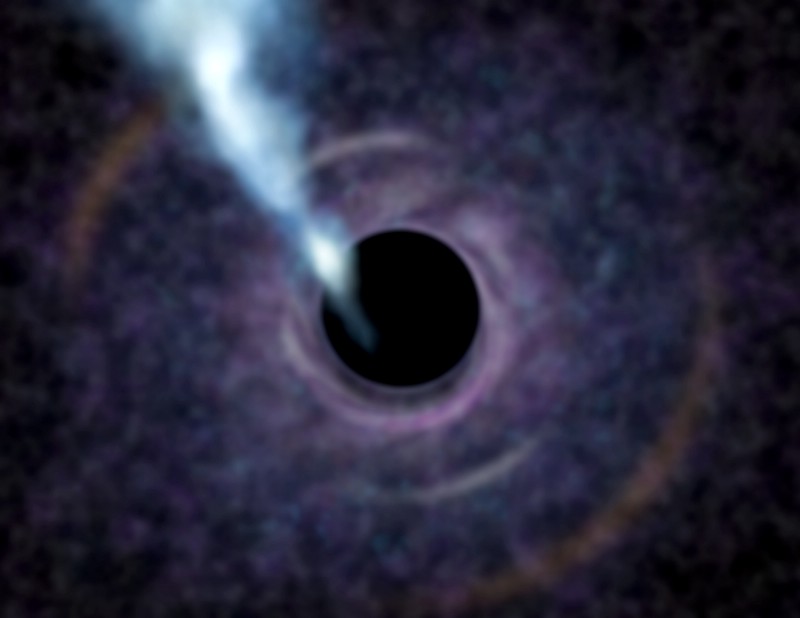
From the outside one cannot say whether a black hole was originally created from protons and electrons, neutrons, dark matter or even antimatter. There are, as far as we can judge, only three characteristics of a black hole, which we can determine by observing it: mass, electric charge and angular momentum, describing the speed of its rotation. Therefore, if we need to find out whether a black hole is originally composed of ordinary, baryonic, matter, or it consists of dark matter, we need to look at:
The astrophysics of how black holes are formed;
The scientific picture of how they, once formed, gain and lose mass
Let's start with their origin.

When you look at a young star cluster in the sky, you will most likely see a set of very noticeable blue stars. Looking closer, you would find that although these stars are the hottest and brightest, they are not representatives of the majority. For every blue giant, there are hundreds of ordinary stars, such as the Sun, or dimmer. In general, only 5% of the stars that have ever formed in the Universe are bigger and brighter than our star!
But it is the largest, hottest and brightest stars that are related to black holes, although they are the rarest. The reason for their brightness is that they burn their nuclear fuel very quickly. A star like the Sun can live 12 billion years until it spends all the fuel in the core, but the star is 10 times more massive than only 0.1% of this period. Consider that the most massive stars we know are hundreds of times more massive than the Sun, and imagine how much less these giants live.

Of course, they can burn and synthesized elements, they can turn helium into carbon, then carbon into oxygen, neon and magnesium, then oxygen into silicon, and then silicon into iron — and each time the star core will contract and heat up.

It is these combustion processes that restrain the star and prevent it from collapsing due to gravity, but iron is the last straw. After this last step, energy is not obtained from the transformation of iron into something heavier, so the core of the star collapses. Neither atoms nor nuclei can hold back gravitational forces, and while the outer shell of the star explodes beautifully and turns into a supernova, the inner part collapses into a black hole.
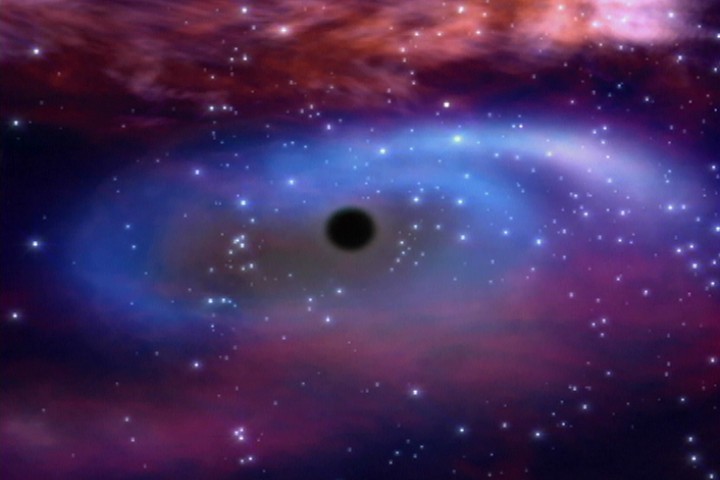
Therefore, at first, when they appear, black holes are 100% composed of normal, baryonic matter, and 0% of dark matter. Dark matter interacts only through gravity, as opposed to ordinary matter, which interacts through gravity, weak, electromagnetic and strong interactions. All this is a complicated way to explain that when ordinary matter interacts with another ordinary matter, it can stick together, clump together, exchange impulses and collect more matter. Dark matter is not crumpled with ordinary matter, nor with itself. Therefore, representing galaxies and clusters, we see spiral or elliptical galaxies, where ordinary matter is collected in a relatively small volume, but they are included in the halo of dark matter, which extends, possibly, to thousands of ordinary volumes.
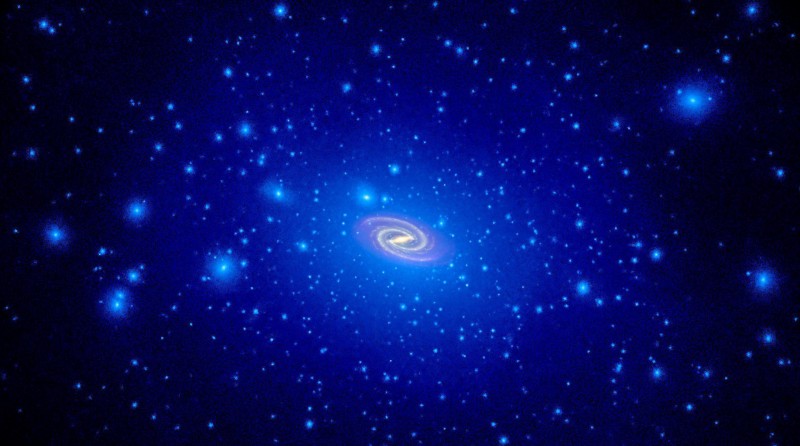
Yes, in large galaxies and dark matter clusters, it is possible that there are five times more than usual. But all this is considered only within the entire huge halo. In those regions of space about which we speak, ordinary matter prevails over dark. Consider our area near the sun. If we draw a sphere with a radius of 100 AU (AU - distance from Earth to the Sun) around the Solar System, we will include in it all the planets, moons, asteroids, almost the entire Kuiper belt, but the baryon mass (of ordinary matter) of what is inside the sphere will mostly belong Sun, and will be about 2 * 10 30 kg. On the other hand, the mass of dark matter in this area will be 1 * 10 19 kg - approximately 0.0000000005% of the mass of ordinary.

For comparison, approximately as much mass is concentrated in the Juneau asteroid, which in the picture below comes under the number "3", and is drawn against the background of the Moon for comparison.

Whether we are talking about individual black holes located thousands of light years away from the centers of the galaxy, or supermassive, resulting from the fusion of many black holes near the galactic nucleus, they all began their existence with a content of about 100% ordinary and 0% dark matter.
But over time, they absorbed both kinds of matter.
Despite the common misconception, black holes do not suck everything inside, they just spread gravitational attraction. Dark matter that would otherwise pass by, being dragged by gravity into the horizon of events, would be eaten by a black hole, which would increase its mass. But ordinary matter, turned out to be near a black hole, will emit waves, disintegrate and lose momentum. It will also interact with the accretion disk, experience friction, lose momentum and increase the amount of matter swallowed. In other words, even when ordinary matter just flies past, part of it is eaten up by a hole - in the case of dark matter this does not happen.
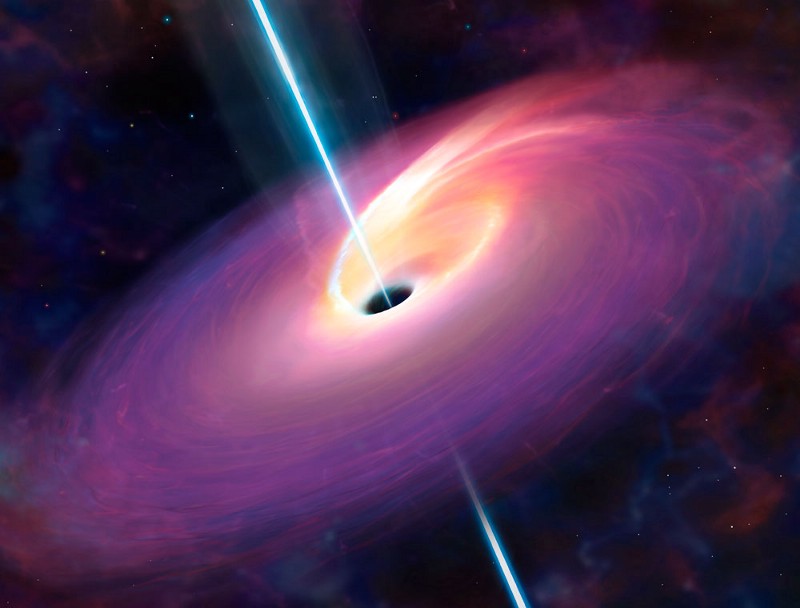
If you need to grow a black hole, the easiest way is to calculate the proportions of ordinary and dark matter eaten by it, taking the proportional density of ordinary and dark matter in this region. For our location, the density of ordinary matter is 1.2 * 10 28 kg per cubic light year, and the density of dark matter is 2.5 * 10 27 kg per cubic light year, or 20% of normal. Not bad!
It must be remembered that we are on the periphery of the Milky Way, and at the center of the galaxy everything is completely different.

It contains even more dark matter, since the density of the halo of dark matter should increase as you move to the center of the galaxy. However, it will not increase so much. There are a lot of uncertainties, but even the most optimistic magnification will give us a multiplier in the region of 10,000. With a pessimistic, or more isothermal, multiplier will be from 10 to 100. On the other hand, the density of normal matter in the galactic center is 50 million times greater than here. we have. And although in our region the contribution of dark matter to the black hole can reach 16%, in the galactic center this number can be no more than 0.004%.
Such is the cruel reality:
- black holes are formed almost entirely from ordinary matter, no matter where it happens
- those that are formed in regions with low density of matter - such as ours - will have a decent portion of dark matter, but on average, its contribution will be much less than the usual contribution
- those that form in regions with a high density of matter - such as the center of the galaxy - will greatly grow in mass, but 99.996% of this mass will be obtained from ordinary matter
So the sad truth is that dark matter is too small a component that participates in the formation of a black hole to influence something, and therefore we will not learn anything special about it.

For those interested in the loss of mass black holes: this is due to Hawking radiation. And although it definitely happens, it goes so slowly that in these time periods it can be neglected. A black hole with a mass from the Sun would need 10 67 years to evaporate, that is, it loses mass less than one electron per year. The largest supermassive black holes of the Universe would take 10,100 years to evaporate, while they lose mass comparable to an electron when it takes as much time as it has since the beginning of the Universe. Therefore, those who hope to see the mass loss will have to wait for the moment when the Universe becomes empty because of dark energy, and black holes will be thrown out of our galaxy due to gravitational interactions before the rate of reduction of black holes equals for absorbing matter.
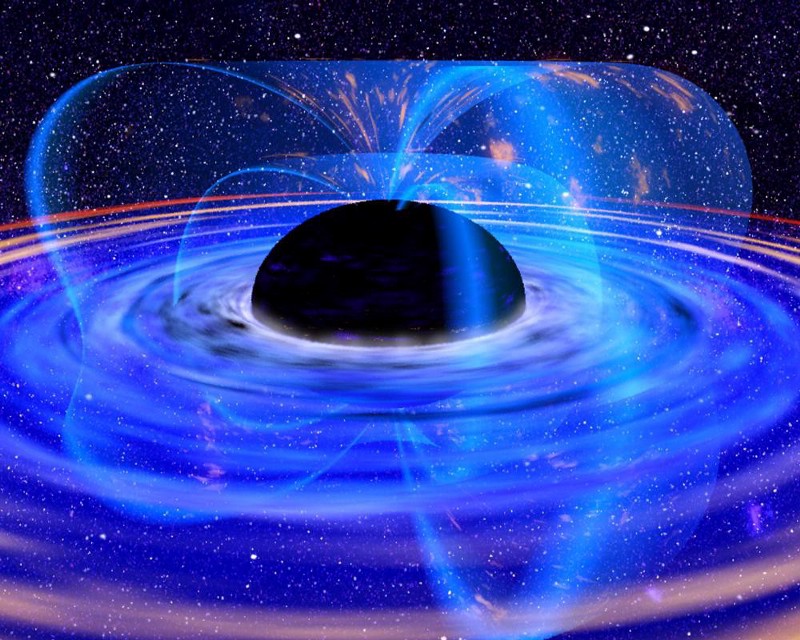
And here is the answer to the question whether black holes are made of dark matter. They can consist of a maximum of 0.004%, and this is the most optimistic estimate for the most massive of them. Thank you for the great question, Michael, and those of you who want to ask a question for the next column can send them to me!
Source: https://habr.com/ru/post/369377/
All Articles